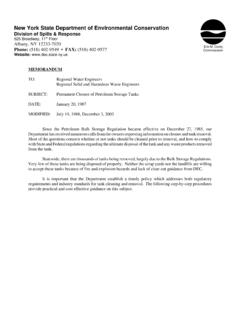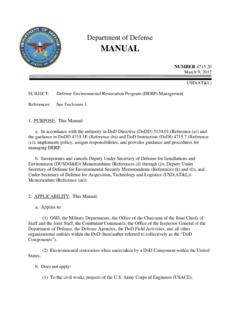Transcription of Perchlorate - United States Environmental Protection Agency
1 United States Office of Solid Waste and EPA 505-F-14-003 Environmental Protection Agency Emergency Response (5106P) January 2014 1 Technical Fact Sheet Perchlorate January 2014 Introduction This fact sheet, developed by the Environmental Protection Agency (EPA) Federal Facilities Restoration and Reuse Office (FFRRO), provides a summary of the contaminant Perchlorate , including physical and chemical properties; Environmental and health impacts; existing federal and state guidelines; detection and treatment methods; and additional sources of information. This fact sheet provides basic information on Perchlorate to site managers and other field personnel who are addressing Perchlorate contamination at cleanup sites or in drinking water supplies. Perchlorate is a persistent contaminant of concern that has presented a number of issues to the government, the private sector and other organizations and interested parties.
2 These issues include health effects and risks, regulatory standards and cleanup levels, degradation processes and treatment technologies (EPA FFRRO 2005). What is Perchlorate ? Perchlorate is a naturally occurring and man-made anion that consists of one chlorine atom bonded to four oxygen atoms (ClO4-) (EPA FFRRO 2005; ITRC 2005). Perchlorate may occur naturally, particularly in arid regions such as the southwestern United States (Rao and others 2007). Manufactured forms of Perchlorate include perchloric acid and salts such as ammonium Perchlorate , sodium Perchlorate and potassium Perchlorate (EPA FFRRO 2005; ITRC 2005). Perchlorate is found as a natural impurity in nitrate salts from Chile, which are imported and used to produce nitrate fertilizers and other products (EPA FFRRO 2005; ITRC 2005). Perchlorate is commonly used as an oxidizer in solid propellants, munitions, fireworks, airbag initiators for vehicles, matches and signal flares (EPA FFRRO 2005; ITRC 2005).
3 It is also used in some electroplating operations and found in some disinfectants and herbicides (ATSDR 2008; ITRC 2005). At a Glance White crystalline solid or colorless liquid. Both naturally occurring and man-made anion. Sampling at current federal sites as well as at Formerly Used Defense Sites detected Perchlorate primarily in association with sites historically involved in the manufacture, maintenance, use and disposal of ammunition and rocket fuel. Highly soluble in water; migrates quickly from soil to groundwater. Primary pathways for human exposure include ingestion of contaminated food and drinking water. Short-term exposure to high doses may cause eye and skin irritation, coughing, nausea, vomiting and diarrhea. Health-based goals or drinking water standards developed by various States . Various detection methods available include ion chromatography, liquid chromatography, mass spectroscopy and electrospray ionization.
4 Common treatment technologies include ion exchange, bioreactors and in situ bioremediation. TECHNICAL FACT SHEET Perchlorate Disclaimer: The EPA prepared this fact sheet from publically-available sources; additional information can be obtained from the source documents. This fact sheet is not intended to be used as a primary source of information and is not intended, nor can it be relied upon, to create any rights enforceable by any party in litigation with the United States . Mention of trade names or commercial products does not constitute endorsement or recommendation for use. 2 Technical Fact Sheet Perchlorate What is Perchlorate ? (continued) Of the domestically produced (high grade) Perchlorate , 90 percent is manufactured for use in the defense and aerospace industries, primarily in the form of ammonium Perchlorate (GAO 2005; ITRC 2005). Perchlorate has been used by the Department of Defense (DoD) as an oxidizer in munitions and missiles since the 1940s (EPA FFRRO 2005; ITRC 2005).
5 Exhibit 1: Physical and Chemical Properties of Perchlorate Compounds (ATSDR 2008; EPA FFRRO 2005; ITRC 2005; NIH 2013; NIOSH 2013) Property Ammonium Perchlorate Sodium Perchlorate Potassium Perchlorate Perchloric Acid Chemical Abstracts Service (CAS) Numbers 7790-98-9 7601-89-0 7778-74-7 7601-90-3 Physical Description (physical state at room temperature) White orthorhombic crystal White orthorhombic deliquescent crystal Colorless orthorhombic crystal or white crystalline powder Colorless, oily liquid Molecular weight (g/mol) Water solubility (g/L at 25oC) 200 2,096 15 Miscible in cold water Melting / Boiling point* (oC) Melting Point: > 200 (Decomposes) Melting Point: 471 to 482 Melting Point: 400 to 525 Melting Point: -112 Boiling Point: 19 Vapor pressure at 25oC (mm Hg) Very low Very low Very low Specific gravity (g/cm3) Octanol-water partition coefficient (log Kow) *Different melting point temperatures are identified in literature.
6 Abbreviations: g/mol grams per mole; g/L grams per liter; oC degrees Celsius; mm Hg millimeters of mercury; g/cm3 grams per cubic centimeter. What are the Environmental impacts of Perchlorate ? Perchlorate is highly soluble in water, and relatively stable and mobile in surface and subsurface aqueous systems. As a result, Perchlorate plumes in groundwater can be extensive. For example, the Perchlorate plume at a former safety flare site (the Olin Flare Facility) in Morgan Hill, California, extends more than 9 miles (EPA 2011; ITRC 2005). Because of their low vapor pressure, Perchlorate compounds and the Perchlorate anion do not volatilize from water or soil surfaces to air (ATSDR 2008; ITRC 2005). Perchlorate released directly to the atmosphere is expected to readily settle through wet or dry deposition (ATSDR 2008). High concentrations of Perchlorate have been detected primarily at current and Formerly Used Defense Sites historically involved in the manufacture, testing and disposal of ammunition and rocket fuel or at industrial sites where Perchlorate is manufactured or used as a reagent during operations (ATSDR 2008; ITRC 2005).
7 Types of military and defense-related facilities with known releases include missile ranges and missile and rocket manufacturing facilities. However, since site-specific documentation may not be available and based on historical uncertainties, it is generally difficult to identify specific military sites with known Perchlorate releases. From 1997 to 2009, the Department of Defense reported Perchlorate detections at 284 (almost 70 percent) of its installations sampled (GAO 2010; ITRC 2005). In addition, the past disposal of munitions in either burial pits or by open burning and open detonation may have resulted in releases to the environment. The amount of Perchlorate released can vary depending on the length of time the disposal area was used and the types of munitions disposed of in the area (ITRC 2005). 3 Technical Fact Sheet Perchlorate What are the Environmental impacts of Perchlorate ?
8 (c ontinued) Studies have shown Perchlorate accumulates in some food crop leaves, tobacco plants and in broad-leaf plants (ATSDR 2008). Surveys conducted by the Food and Drug Administration have detected Perchlorate in food crops and milk (FDA 2008). As of October 2009, Perchlorate had been detected at varying levels in drinking water, groundwater, surface water, soil or sediment at private and federal facilities in 45 States , three territories and Washington The maximum concentrations reported in any media ranged from less than 4 parts per billion (ppb) to more than 500,000 ppb (ASTSWMO 2011; GAO 2010). EPA reported Perchlorate detections at more than 40 hazardous waste sites on the EPA National Priorities List as of June 2010 (GAO 2010). What are the routes of exposure and the health effects of Perchlorate ? Primary pathways for human exposure to Perchlorate are ingestion of contaminated food and drinking water (ATSDR 2008; EPA FFRRO 2005).
9 Perchlorate is readily adsorbed after oral exposure and can migrate from the stomach and intestines to the bloodstream (ATSDR 2008). The thyroid gland is the primary target of Perchlorate toxicity in humans. Thyroid hormones play an important role in regulating metabolism and are critical for normal growth and development in fetuses, infants and young children. Perchlorate can interfere with iodide uptake into the thyroid gland at high enough exposures, disrupting the functions of the thyroid and potentially leading to a reduction in the production of thyroid hormones (ATSDR 2008; Cal/EPA 2012; NAS 2005). Study results indicate that exposure to high doses of Perchlorate can result in the decrease of body weight, cause hypertrophy of the thyroid gland and decrease gene expression of thyroglobulin (Tg) and thyroperoxidase (TPO), which are involved in the biosynthesis of thyroid hormones (Wu and others 2012).
10 Potassium Perchlorate was historically used to treat hyperthyroidism and Graves Disease (an autoimmune disorder) because of its ability to inhibit thyroid iodide uptake (ATSDR 2008; NAS 2005). Studies conducted on rodents showed that Perchlorate concentrations below that required to alter thyroid hormone equilibrium are unlikely to cause thyroid cancer in human beings (ATSDR 2008; EPA IRIS 2005). Short-term exposure to high doses of ammonium, sodium or potassium Perchlorate may cause eye, skin and respiratory tract irritation, coughing, nausea, vomiting and diarrhea. Perchloric acid is corrosive to the eyes, skin and respiratory tract, and short-term exposure to high doses may cause sore throat, coughing, labored breathing, deep burns, loss of vision, abdominal pain, vomiting or diarrhea (NIOSH 2013). Are there any federal and state guidelines and health standards for Perchlorate ?















